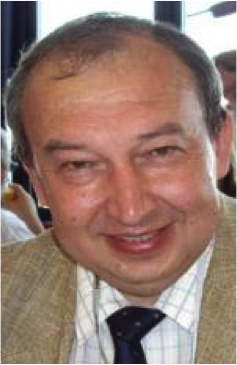
Mikhail N. Filippov
Head of Laboratory, Dr. of Sciences (Physics and Mathematics), Professor
- Study and development of chemical analysis methods for non-ferrous, rare, and precious metals and high-purity substances.
- Metrology and standardization of chemical analysis methods.
- Development of methods for local analysis, nanoanalysis, X-ray fluorescence, and powder X-ray diffraction analysis.
- Development of atomic-spectral methods for the analysis of inorganic substances and materials.
- International cooperation in the field of chemical analysis.
A set of methods for the analysis of rare metals and reusable metal-containing raw materials with improved metrological characteristics was developed and certified.
A methodology for the application of high-purity substances as primary standards of comparison in determining the metrological traceability of analytical methods was proposed.
Theoretical, experimental, and methodological foundations of electron probe X-ray microanalysis, using the characteristic radiation lines in the soft range of the X-ray spectrum as an analytical signal (quantum energy from 100 eV to 1 keV) were created.
A mathematical model for the thermal effect of a focused electron beam on an object under study in electron probe X-ray microanalysis was developed.
- Nikolay A. Abramov Head Technologist
- Vasilisa B. Baranovskaya Leading Researcher, Dr. of Sciences (Chemistry)
- Yuri A. Karpov Head Researcher, Academician of RAS
- Olga I. Lyamina Senior Researcher, Ph.D. (Engineering)
- Elena V. Fatyushina Senior Researcher, Ph.D. (Engineering)
- S. A. Darznek, V. B. Mityukhlyaev, P. A. Todua, M. N. Filippov. Electron probe X-ray spectral analysis of nanoparticles // Inorganic materials. 2018. V. 54(14). p. 1412–1416.
- V. Eskina, O.A. Dalnova, D.G. Filatova, V.B. Baranovskaya, Yu.A. Karpov. Separation and concentration of platinum, palladium and rhodium from exhausted automobile catalysts solutions using heterochain polymer S, N-containing sorbent with subsequent theirs determination by high-resolution continuum source graphite furnace atomic absorption spectrometry // Talanta. 2016. V. 159. p. 103–110.
- Yu.A. Karpov, V.B. Baranovskaya. The analytical control as an integral part of material diagnostics // Inorganic materials. 2018. V. 54(14). p. 1363–1370.
- M. S. Doronina, Yu. A. Karpov, V. B. Baranovskaya. Advanced techniques for sample processing of the reusable metal-containing raw material (Review) // Inorganic materials. 2017. V. 53(14). p. 1391–1398.
- A. Yu. Kuzin, V. B. Mityukhlyaev, P. A. Todua, M. N. Filippov. Change in the chemical composition of an analyzed object during low-voltage electron probe X-ray spectral microanalysis // Measurement Technics. 2017. V. 59(11). p. 1234–1237.
- Yu. Medvedevskikh, A.S. Sergeev, O.S. Shokhina, V.V. Baranovskaya, Yu.A. Karpov. Specific features of determinations of the composition of high-purity lanthanide crystal hydrates // Journal of Analytical Chemistry. 2016. V. 71(6). p. 561–568.
- A. Karpov, V.B. Baranovskaya. Possibilities and issues of current analytical chemistry of inorganic materials // Russian Chemical Bulletin, International Edition. V. 64(8). p. 1989–1995.
- A. Karpov – Order of Friendship of Peoples (1987), Prize of the Government of the Russian Federation (2001), Order of Honor (2003), Academician I.I. Chernyaev Commemorative Medal for his outstanding contribution to the development of chemistry, analysis and technology of platinum metals, Appreciation from the President of RAS “For many years of fruitful work at the Interdepartmental Scientific Council on the complex problems of physics, chemistry and biology at the Presidium of the Russian Academy of Sciences in connection with its 25th anniversary” (2006)
- B. Baranovskaya – Certificate of the Ministry of Education and Science of the Russian Federation for his personal contribution to the development of domestic science (2011), ROSATOM State Corporation Award “Person of the Year 2013” in the nomination “Scientist–Chemist” (2013)
Grants of the Russian Science Foundation
- 14-13-00897. Combining complementary methods of chemical diagnostics of non-ferrous, rare, precious metals, high-purity substances, their compounds, and precursors (2014–2015)
Grants of the Russian Foundation for Basic Research
- 17-03-01014. Development of general principles for the analysis of samples of complex composition by electrothermal atomic absorption spectrometry with continuous radiation source (2017–2019)
- 16-03-00515-a. Electron-stimulated changes in composition of inorganic substances and materials in local analysis (2016–2018)
- 13-03-00903-a. X-ray fluorescence analysis of condensed samples using fundamental bonds in emission spectra of elements (2013–2015)
Projects in basic research programs of the Presidium of the Russian Academy of Sciences
- X-ray spectral analysis using additional information signals (2015–2017)
- Vernadsky Institute of Geochemistry and Analytical Chemistry RAS (Moscow)
- Baykov Institute of Metallurgy and Materials RAS (Moscow)
- Devyatykh Institute of Chemistry of High-Purity Substances RAS (Nizhny Novgorod)
- Federal State Research and Design Institute of Rare Metal Industry Giredmet (Moscow)
- VMK Optoelectronics (Novosibirsk)
- Ekaterinburg Non-Ferrous Metals Processing Plant (Ekaterinburg)
- Association of Analytical Centers of Russia “Analytics” (Moscow)
- Moscow State University (Moscow)
- Moscow Technological University MIREA (Moscow)
- National University of Science and Technology MISIS (Moscow)
- Tsiolkovsky Kaluga State University (Kaluga)
- Al-Farabi Kazakh National University (Republic of Kazakhstan)
- European Society for Metrology in Analytical Chemistry “Eurachem”
- Cooperation on International Traceability in Analytical Chemistry (CITAC)